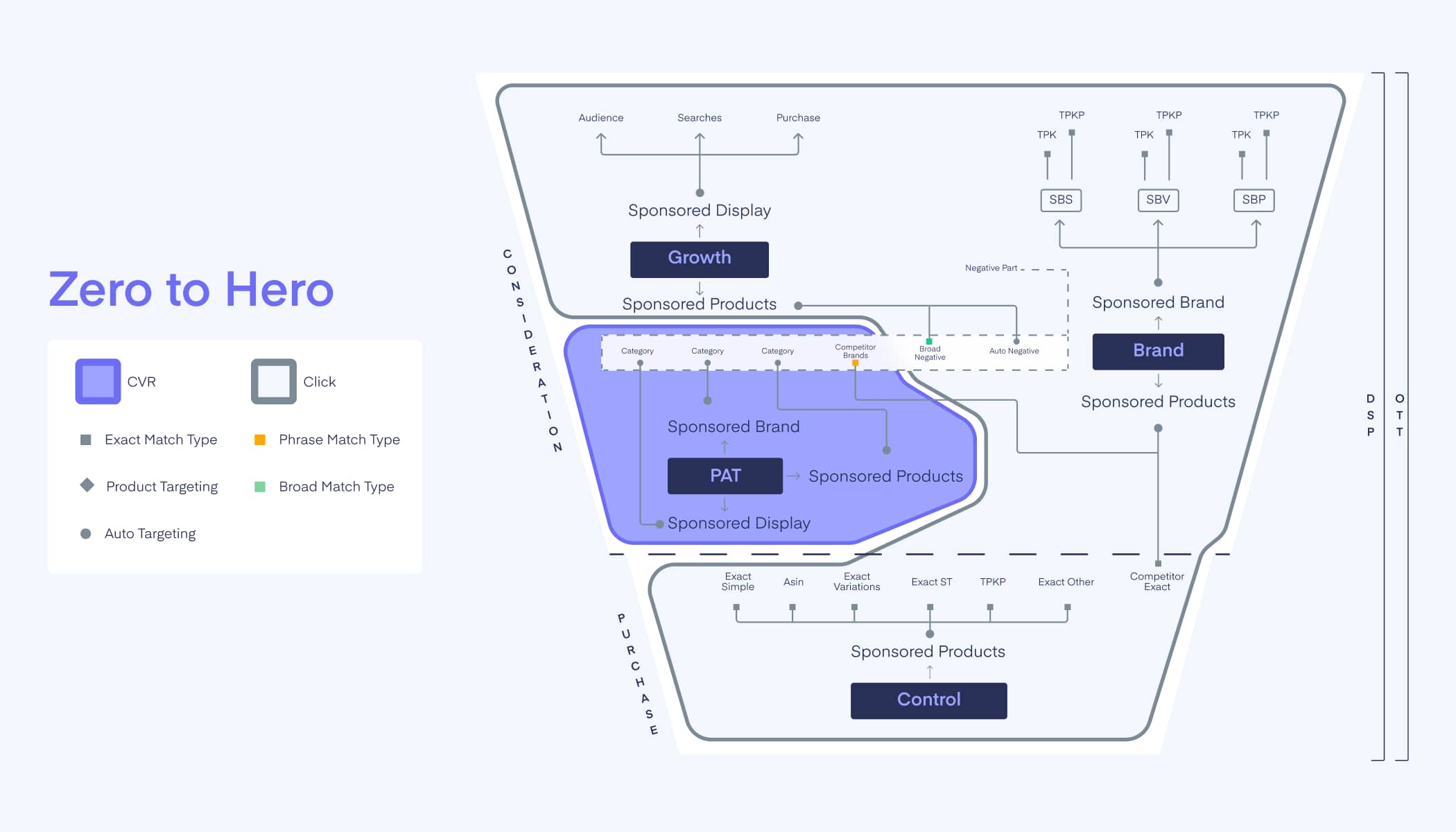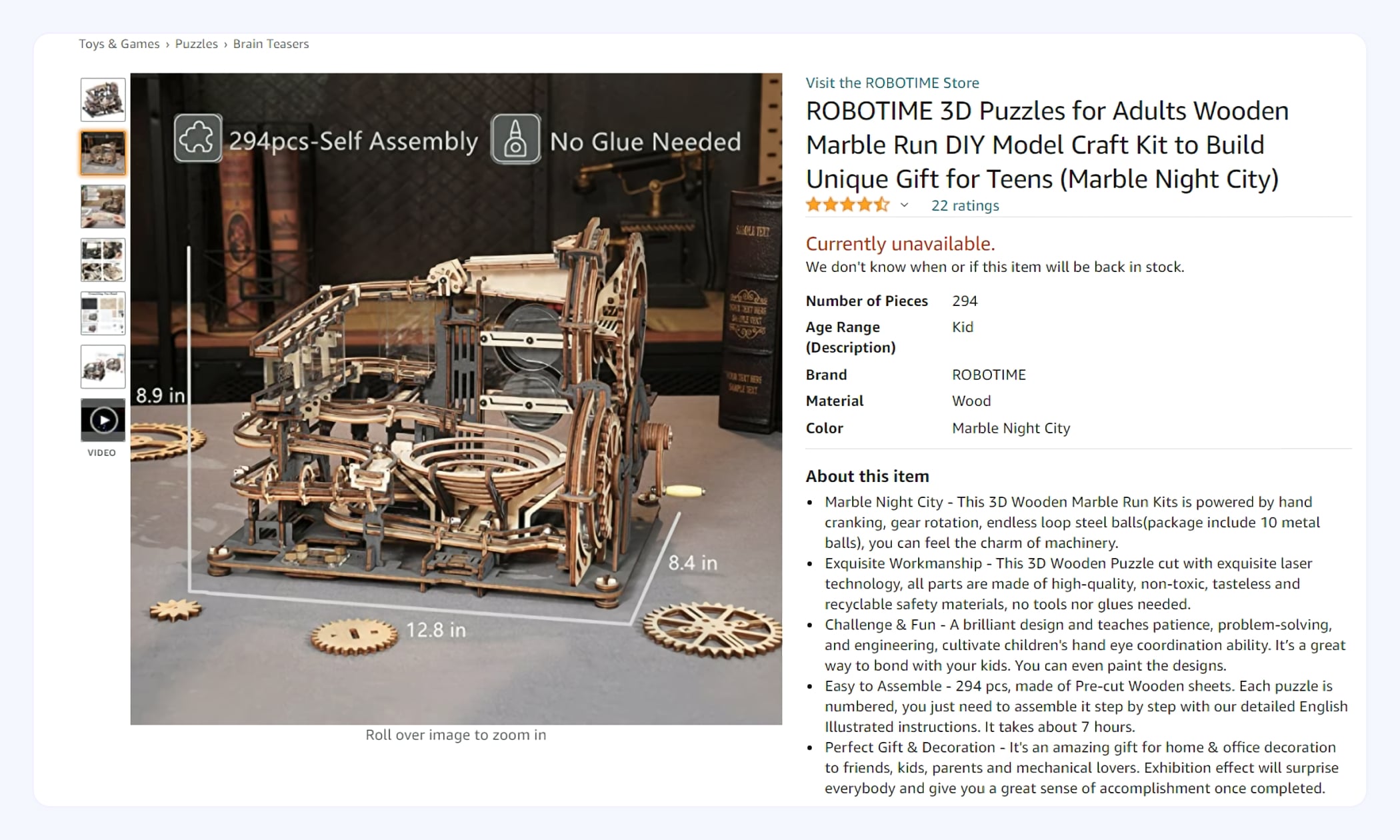
Find out how an auto-targeted PPC campaign has reduced a beauty brand’s ad budget and increased a conversion rate


In this article, we’ll consider the importance of Amazon PPC campaign structure and explain in detail how Profit Whales assembles and sets it up.
Table of content:
Running an online advertising campaign has become the newest golden ticket to the welcome wagon for many ambitious business owners. But this field can sometimes feel like a minefield of challenges and pitfalls. With so many possibilities on the market, it is difficult to pinpoint the best choices and easy to get lost.
Amazon PPC campaign structure will make it easy to define your goals and to set parameters for each of your ads. If set up correctly, the Amazon PPC structure can bolster your digital ad strategy. It can also help:
When you create a PPC campaign, you’re dealing with a strategy that’s very dependent on what you’re trying to accomplish. And that means that every aspect has to be carefully considered and well-executed to meet your objectives. Let’s set up an Amazon Campaign Structure step by step with Profit Whales.
In the graph below, we’ve illustrated our unique approach to structuring a PPC campaign for Amazon sellers.

It’s color-separated: the green part is responsible for receiving conversions of competitors, and the blue – for the share of clicks.
To have a deeper understanding of how Profit Whales uses various campaigns, see the comment below from our expert analyst.
“We always work towards increasing customer traffic: by correctly ranking keywords, we increase traffic and coverage. This way, the number of impressions increases, and with that comes an increase in sales. Specifically, the green part in the graph above is aimed at hitting bestseller status, and this is what we at Profit Whales call “the double-strike.” How does it work?
The seller needs to sell more products than others, that is, more than competitors. When sellers get their share of impressions and sales, they grow, just like the rest of the market. But when they not only receive new traffic but also take away sales, they receive extra while competitors are deprived of that.
For example, let’s say you sold 50 units of a product and a competitor sold 40. As soon as you take away those 5 sales, you get 55 sold while a competitor gets 35. The difference increased by 20 sales due to only 5 new purchases. This is what we call a double-strike.”
—Michael, Profit Whales Analyst
Let’s overview this graph in more detail. What exactly is the blue part of the graph aimed at?
The Growth part includes Sponsored Products and Sponsored Display.
Sponsored Products comprises of:
Auto campaigns are automatically managed by Amazon, and you can only influence the traffic you receive through rate adjustments and negative keywords. We at Profit Whales use this campaign for a different purpose, namely to increase the indexed portion of the listing. To do this, we add all keywords without duplicates to Negative Exact.
We manage all search terms that we index through other campaigns and negative keywords. All of these keywords are under our control, and Amazon finds searches and targets that we do not have in the campaign. This helps improve general indexing and find keywords that we might not even know about.
Sponsored Display includes:
The Brand part includes Sponsored Products and Sponsored Brands.
Sponsored Brand include:
With this type of campaign, you can control the placement by setting the appropriate “percentage” in order to always appear at the Top of Search. However, such a strategy will only be relevant if your listings have competitive offerings.
If your product prices are higher, your listing has fewer reviews and worse ratings than your competitors, then you shouldn’t get into the ToS, as your conversion rate in this placement will probably be extremely low. In such circumstances, you should aim for Product Pages or Rest of Search.
Sponsored Products comprise:
This campaign includes keywords from competitors’ brands and can be used to protect your brand. You can also use this campaign to keep your competitors from driving traffic.
This part consists of Sponsored Products only – the most complex ad campaign that brings 50-70% of traffic and, if properly managed, brings massive volumes of conversion. Here we utilize the following strategies:
Exact Simple includes high-frequency and mid-frequency keywords. You can split them into clusters, or you can manage all the keywords together using dynamic optimization. In fact, you can have as many as one or a dozen of such campaigns. These are the most common campaigns where you divide your keywords into segments to control budgets and placements for each of them separately.
For instance, let’s say you have two segments for the Headphones product:
Then you create campaigns by each of these segments: 1) Exact Simple “iPhone” in which all the keywords contain the word “iPhone”; 2) Exact Simple “Android” in which all the keywords contain the word “Android.”
Within such campaigns, you can also subdivide segments into even narrower options:
Exact Variations campaign is used in case your product has several variations (for example, shorts in different colors and sizes). You can align the keywords according to their variations (for example, green shorts XL), so the shoppers will find the desired variation by typing this very request.
Imagine you are selling a women’s dress in three colors, Black, Blue, and Yellow. If a client types “Women Dress Black” in the search field, it is logical to show a black dress in the SERP and not Yellow. This campaign includes all keywords where the client needs to visually see exactly what they are looking for, dividing the campaign into clusters for each variation: size, color, fabric, etc.
Collecting semantics, you will definitely have keywords that will not find a “couple” for themselves. Within this campaign, you should utilize all unique keywords that we cannot attribute to any of the segments. As a rule, these are low-frequency keywords consisting of more than three words (for instance, radio nonshock bark collar).
Let’s say there is only one such keyword in all semantics – a “professional 3.0 USB car charger”. It turns out to be relevant, but it is unique, so you should put all such keywords in one campaign.
If you have already had running campaigns and are worried that while collecting new semantics, you might have missed something, Search Terms Exact can help you. ST Exact campaign is where you should add the keywords from the search terms report that generated at least two sales.
We use this campaign to help sellers find additional keywords that they couldn’t find in the semantics. Then, we sort and add them to the ST Exact campaign or scatter them by keyword groups in Exact campaigns.
One important note about the Sponsored Products campaign: it includes the top-performing keywords only, those that consume 70% of the total budget and are the most competitive (bring huge traffic). They are called the Seed Keywords – short-tail keywords that most relevantly describe your product. As a rule, they are included in the Title.

For the item above, the seed keywords would be the following:
You can look through the competitors’ listings and “steal” their seeds. Typically, the seed is composed of up to three highest-frequency keywords. They are the skeleton of your future semantics that will serve as the base for all other keywords.
You need to build your seeds out of two-three words. One-word seeds are too “broad,” thereby plenty of irrelevant keywords will be collected on their basis. You will have to spend a lot of time trying to eliminate them.
Now, let’s overview the PAT part. It comprises of:
You will need the ASINs from the Search Term Report for the creation of TPA / PA / RA campaigns. At first, you can limit yourself only to what Amazon offers you (Suggested ASINs), and gradually create and populate other types of campaigns as data accumulates.
Note: If you have not run any ad campaigns before, skip creating TPA / PA / RA campaigns and set them up once you have enough data.

Remember, there should be no duplicates in these campaigns.
Top Performance ASINs is a campaign to which you should add ASINs that have statistics and sales (if you have previously advertised this product for a while). These are the top ASINs that you are most confident in and which will work with the highest bids. You should add on average 7-15 of the top ASINs that bring you the biggest volume of sales and have low ACoS (or at least acceptable to you.
This is a campaign to which you should add ASINs that generate two-three sales with good ACoS for you and with a sufficient Conversion Rate.
This is a campaign within which you should add ASINs you want to check and collect data on. For instance, if an ASIN generated just one sale, you might want to check whether it is worth your ad investment. This campaign will work with low bids (lower than all others in the PAT part), and at the same time, if an ASIN starts to perform well, you can move it to the TPA for better control.
These are ASINs offered by Amazon. It is recommended to filter this list before the setup choosing the ones you can compete with. For example, it could be an ASIN with a higher price, fewer reviews, and worse ratings. Certainly, it makes no sense to advertise on a listing that has several times more reviews and is cheaper than yours.
Top Competitor ASINs are the resembling competitors (in terms of price, reviews, etc.) that you can beat and strategic competitors that have a lot of traffic and promoted listings. For example, if you want to get the Best Seller badge, you should target the top ten competitors within your category if you have a competitive offer.
This is a campaign that allows you to target your own products so that competitors do not steal traffic. You can also add your listings’ ASINs to the targeting.
By examining the previous campaigns and Search Term Report, you can protect your ads in advance by excluding poorly performing keywords from semantics and adding them to campaigns such as Auto Negative and Broad Negative.
Understanding Amazon PPC campaign structure is a crucial skill for a marketer to have. Brand awareness is the end game of marketing. Without it, you don’t have a marketing strategy. And marketing strategy exists to transform consumers into passionate advocates.
It can take a long time to organize, structure, and take care of your PPC campaigns, but ultimately it is worth it!
If you feel like you need help structuring your Amazon PPC campaigns properly, our team will be happy to help you! Contact us today, and together we will find the best solution for you!
Hi! I am a PPC Associate and I was having trouble understanding your strategy/approach with broad and exact negatives. Can you explain this more?
Hello Emily. Sure, we would love to share a bit more info on the negatives. We are always negating all “exats’ in Auto campaign so, in this way, Amazon only shows our ads for search terms that we didn’t use in our structure. Moreover, we negate everything in broad company with the seed keywords inside to guide Amazon on what direction we want to find new keywords. This tactic is called “Search term isolation.”